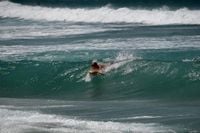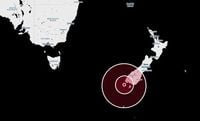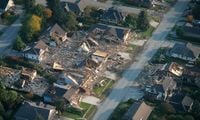A magnitude 6.8 earthquake struck off the coast of South Island, New Zealand, on March 25, 2025, creating significant tremors felt across the region and prompting a swift response from emergency management agencies. The quake occurred at 2:43 PM local time, about 160 kilometers northwest of the Snares Islands, and at a depth of 33 kilometers in a seismically active area known for its tectonic shifts.
In the wake of the earthquake, New Zealand's National Emergency Management Agency (NEMA) issued a tsunami advisory. While there were no evacuation orders necessary, residents were warned to steer clear of coastal waters, with officials advising that strong currents and hazardous surges could pose serious threats. "Strong currents and surges can injure and drown people. There is a danger to swimmers, surfers, people fishing, and anyone in or near the water close to shore," NEMA stated, highlighting the urgency of the situation.
As the warning spread, areas along the west coast of South Island, particularly from Milford Sound to Puysegur Point, faced potential risks. Emergency Management Southland clarified that there was no tsunami threat for the coast of Southland. Mark Mitchell, a local official, reassured the public, saying, "Evacuations are NOT required but there is potential danger near the shoreline. We are asking people to stay away from the beach and water. Strong and unusual currents may be experienced."
Initially, the quake was reported as a magnitude 7.0 before being revised by the US Geological Survey (USGS) to 6.8, and then finally settled at 6.7. This adjustment reflects the challenges faced by seismologists in accurately assessing tremors, especially in less-studied regions. Notably, this area is adjacent to the Puysegur Trench, a dangerous tectonic boundary where the Australian plate subducts under the Pacific plate.
Following the earthquake, thousands of residents reported feeling the ground shake, with anecdotes captured through social media. One individual shared on Facebook, "We had things fall off shelf. The outdoor wooden table dancing," illustrating the suddenness and the physical impact of the quake. Local businesses felt the tremors as well; Mark Hewton, owner of Tuatapere Four Square, noted, "It was a very soft rolling earthquake. It wasn't aggressive. It wasn't enough to cause any damage that I'm aware of." His reassurance reflects the more common experiences shared by those in the vicinity.
Educational institutions also responded to the situation, with reports of students being moved to evacuation points. One teacher described how, "Students were evacuated to a field and clearing area, and we were required to walk to the old hospital where buses would come in due course." This quick response highlights the community's commitment to ensuring safety amid uncertainty.
Experts continue to analyze the event, highlighting the seismic intricacies of the Puysegur Trench. Dr. Finn Illsley-Kemp, a seismologist involved in studying this tectonic zone, emphasized the uncertainty surrounding the area. He stated, "There is still much we don’t know about this area," underlining the importance of ongoing research and monitoring in understanding such hazardous regions. Historically, places like the Puysegur Trench have produced powerful earthquakes, making vigilance essential.
Beyond New Zealand, the U.S. National Tsunami Warning Center confirmed that there was no expected tsunami threat for the west coast of the United States or British Columbia, reassuring those who might have been concerned about the potential for larger waves. They noted their monitoring of the situation closely, indicating that while New Zealand was under precaution, the mainland was safe from tsunami impacts.
In summary, while the earthquake raised alarm bells and prompted emergency advisories, the effects appeared to be manageable thus far, with no immediate reports of significant damage. Residents have been urged to remain attentive as aftershocks could occur, but community resilience and effective communication have paved the way for recovery. It’s a reminder of New Zealand’s position along the volatile Ring of Fire, where seismic activity is a constant aspect of life, necessitating a preparedness that has proved vital in the face of nature’s unpredictability.






